The snowy albatross is the largest flying bird, with a wingspan of up to 3.7 meters (12.1 feet). The great bustard is the heaviest, reaching 21 kilograms (46 pounds), while the sarus crane is the tallest at 1.8 meters (5.9 feet). Each species has evolved unique flight adaptations, from dynamic soaring to powerful takeoffs. This article ranks the world’s largest flying birds by wingspan, weight, and height, exploring the remarkable extremes of avian flight.
Snowy albatross (Diomedea exulans)
- Wingspan: Up to 3.7 m (12.1 ft).
- Weight: Up to 12.7 kg (28 lbs).
- Where found: Southern Ocean; breeds on subantarctic islands.
- Conservation status: Vulnerable.

The snowy albatross, also known as the wandering albatross, holds the record for the largest wingspan of any living bird, reaching up to 3.7 meters (12.1 feet). Along with its immense wings, it has a body length of up to 1.4 meters (4.6 feet) and can weigh up to 12.7 kilograms (28 pounds), making it one of the heaviest seabirds. This giant of the Southern Ocean is a master of dynamic soaring, using wind currents to stay aloft for hours with minimal effort. Despite its size, it is built for endurance rather than speed, covering thousands of kilometers without flapping its wings. Its long, slender wings allow it to glide effortlessly over turbulent waters, making it a near-permanent resident of the open ocean.
This heavy seabird depends on its specialized flight mechanics to minimize energy expenditure, spending most of its life airborne and only returning to land for breeding on remote subantarctic islands. With a lifespan exceeding 50 years, some individuals circle the globe multiple times in their lifetime. Despite its size and adaptability, the snowy albatross faces significant threats from bycatch in longline fisheries and plastic pollution, both of which have contributed to its population decline. Classified as Vulnerable by the IUCN, this oceanic giant remains at risk, reminding us that even the largest birds are not immune to human impact.
Southern royal albatross (Diomedea epomophora)
- Wingspan: Up to 3.5 m (11.5 ft).
- Weight: Up to 10.3 kg (23 lbs).
- Where found: Southern Ocean; breeds on subantarctic islands.
- Conservation status: Vulnerable.

The southern royal albatross is among the largest flying birds in the world, with a wingspan reaching up to 3.5 meters (11.5 feet). It has a body length of up to 1.2 meters (4 feet) and can weigh up to 10.3 kilograms (23 pounds). Closely related to the snowy albatross, this massive seabird dominates the subantarctic skies, using its enormous wings to glide effortlessly across vast oceanic distances. It breeds primarily on Campbell Island and the Auckland Islands, where it forms colonies on rugged, windswept terrain.
Like many large seabirds, the southern royal albatross faces significant threats from longline fishing, habitat disturbance, and climate change, all of which affect its breeding success and food availability. Due to these pressures, it is classified as Vulnerable by the IUCN, indicating a declining population. Conservation efforts, including fisheries management and habitat protection, are crucial to ensuring that this oceanic giant remains a common sight in the Southern Hemisphere.
Dalmatian pelican (Pelecanus crispus)
- Wingspan: Up to 3.51 m (11.5 ft).
- Weight: Up to 15 kg (33 lbs).
- Where found: Lakes, rivers, and deltas across southeastern Europe, central Asia, and parts of China and India.
- Conservation status: Near Threatened.

The Dalmatian pelican is one of the largest freshwater birds in the world and the heaviest pelican species, with some individuals weighing up to 15 kilograms (33 pounds). Its wingspan can reach an impressive 3.51 meters (11.5 feet), making it one of the widest-winged birds in the world. This massive waterbird is known for its striking silvery-white plumage, a distinctive curly nape, and an enormous bill that can hold up to 13 liters (3.4 gallons) of water. Unlike some of its relatives, the Dalmatian pelican prefers freshwater lakes, rivers, and marshes rather than coastal environments, where it hunts fish by dipping its long bill into the water.
Despite its size, this giant pelican is an agile and powerful flier, using slow, deep wingbeats to stay aloft. However, its population has been declining due to habitat loss, wetland drainage, and human disturbance. Conservation programs, including wetland protection and reintroduction efforts, have helped stabilize some populations, but its future remains uncertain. Listed as Near Threatened by the IUCN, this wetland giant depends on continued efforts to safeguard its remaining habitats.
Great white pelican (Pelecanus onocrotalus)
- Wingspan: Up to 3.6 m (11.8 ft).
- Weight: Up to 15 kg (33 lbs).
- Where found: Wetlands, lakes, and estuaries across Africa, Europe, and Asia.
- Conservation status: Least Concern.

The great white pelican is one of the largest waterbirds, known for its broad wings, enormous bill, and striking white plumage. With a wingspan reaching up to 3.6 meters (11.8 feet), it is among the widest-winged flying birds, rivaling even some albatrosses. Despite its bulk, this species is an efficient and graceful flyer, often soaring in formation with other pelicans. It thrives in shallow lakes, marshes, and estuaries, where it feeds primarily on fish, using its large, expandable throat pouch to scoop up prey.
Unlike its Dalmatian relative, the great white pelican has a more stable population and is classified as Least Concern. However, certain regional populations are at risk due to wetland degradation, pollution, and human disturbance. While many colonies remain strong, ongoing conservation efforts are crucial in areas where habitat loss threatens local breeding sites.
Amsterdam albatross (Diomedea amsterdamensis)
- Wingspan: Up to 3.4 m (11.2 ft).
- Weight: Up to 8 kg (17.6 lbs).
- Where found: Breeds exclusively on Amsterdam Island in the southern Indian Ocean.
- Conservation status: Endangered.
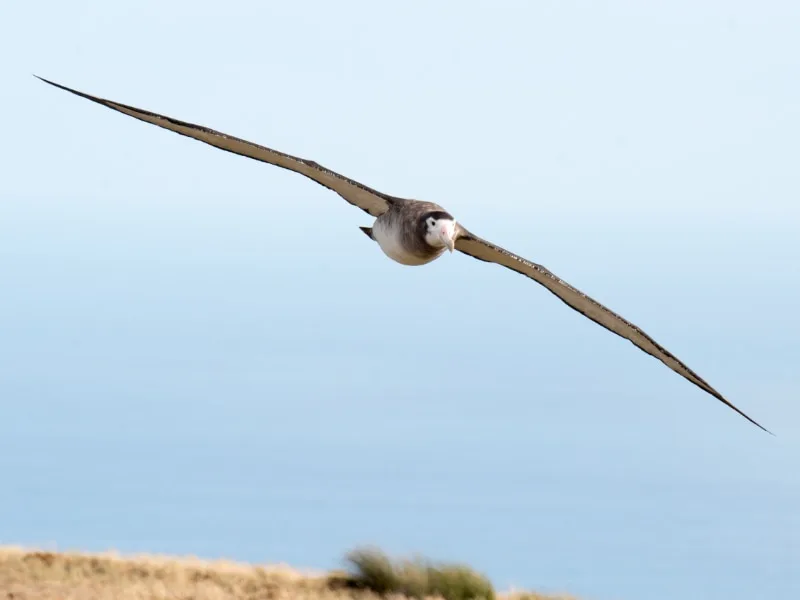
The Amsterdam albatross boasts an impressive wingspan reaching 3.4 meters (11.2 feet), ranking it among the largest flying birds. This majestic seabird is unique in its breeding habits, nesting solely on the Plateau des Tourbières of Amsterdam Island, a remote territory in the southern Indian Ocean. With a total population estimated at around 130 individuals, including 80 mature birds, its rarity adds to its significance.
Historically, the species faced severe threats from habitat degradation due to introduced species like feral cattle and predation by feral cats. Conservation efforts have led to positive changes, such as the removal of feral cattle by 2010, allowing habitat recovery. While the population has shown a slight increase, the Amsterdam albatross remains Endangered, with ongoing concerns including disease and potential bycatch in longline fisheries.
Andean condor (Vultur gryphus)
- Wingspan: Up to 3.3 m (10.8 ft).
- Weight: Up to 15 kg (33 lbs).
- Where found: Andes Mountains and coastal regions of South America.
- Conservation status: Vulnerable.

The Andean condor is one of the largest flying birds by wingspan and the heaviest raptor in the world. With wings stretching up to 3.3 meters (10.8 feet) and a body weight of up to 15 kg (33 lbs), it is a true giant of the skies. Unlike many birds of prey, it relies on thermal updrafts to soar effortlessly over the rugged terrain of the Andes Mountains, conserving energy as it searches for carrion. Its characteristic black plumage, white collar, and bald head make it easily recognizable, while its hooked beak is perfectly adapted for scavenging.
Despite its dominance in the skies, the Andean condor faces significant threats, including habitat loss, poisoning, and human persecution. Once widespread, its populations have declined in many areas, leading to its classification as Vulnerable by the IUCN. Conservation programs, including reintroduction efforts and legal protections, are crucial in ensuring the survival of this majestic scavenger across its range.
California condor (Gymnogyps californianus)
- Wingspan: Up to 3.0 m (9.8 ft).
- Weight: Up to 14 kg (31 lbs).
- Where found: Western United States and northern Mexico.
- Conservation status: Critically Endangered.

The California condor is the largest bird in North America, with a wingspan reaching up to 3 meters (9.8 feet). Its broad, black wings, distinctive bald head, and white underwing markings make it unmistakable in flight. Once widespread across the continent, this species was driven to the brink of extinction due to habitat loss, lead poisoning, and hunting. By the 1980s, only 27 individuals remained in the wild, prompting an ambitious captive breeding program that has since reintroduced condors to parts of California, Arizona, Utah, and Mexico.
Despite successful conservation efforts, the species remains critically endangered and is one of the rarest birds in North America, with a population that still relies on intensive management. Threats such as lead poisoning from spent ammunition, habitat destruction, and collisions with power lines continue to hinder its recovery. However, dedicated conservation programs and ongoing reintroduction efforts offer hope that this ancient scavenger will continue to soar over the American West for generations to come.
Great bustard (Otis tarda)
- Wingspan: Up to 2.7 m (8.9 ft).
- Weight: Up to 21 kg (46 lbs).
- Where found: Open grasslands and steppes of Europe and Central Asia.
- Conservation status: Endangered.

The great bustard is the heaviest recorded flying bird, with males reaching up to 21 kilograms (46 pounds) – the highest verified weight for any bird capable of sustained flight. While its size allows for flight, it prefers to walk or run across the vast grasslands of Europe and Central Asia. Recognized by its rich brown plumage, bold white markings, and striking mustache-like feathers during breeding season, this species remains an iconic sight in open landscapes.
Once widespread, the great bustard’s population has suffered from habitat destruction, agricultural expansion, and hunting. Now classified as Endangered, it relies on conservation programs, habitat restoration, and anti-hunting laws to prevent further decline. While some populations have stabilized, continued protection is essential to ensure the survival of this grassland giant.
Kori bustard (Ardeotis kori)
- Wingspan: Up to 2.75 m (9 ft).
- Weight: Up to 20 kg (44 lbs).
- Where found: Open savannas and grasslands of eastern and southern Africa.
- Conservation status: Near Threatened.

The kori bustard is the heaviest flying bird by average weight, with males typically ranging from 10 to 16 kilograms (22-35 pounds) and occasionally reaching 19-20 kilograms (42-44 pounds). While fully capable of flight, it spends most of its time on the ground, taking to the air only when absolutely necessary. With long legs, a sturdy frame, and striking plumage, this bird blends seamlessly into the open grasslands of eastern and southern Africa, where it forages for insects, small vertebrates, and plant matter.
Despite its large size, the kori bustard is vulnerable to habitat degradation, hunting, and collisions with power lines. Its reliance on undisturbed savannas has led to population declines, and it is now classified as Near Threatened (IUCN). Conservation efforts focus on habitat protection and reducing human disturbances, ensuring that this giant of the African plains continues to thrive in its natural environment.
Marabou stork (Leptoptilos crumenifer)
- Wingspan: Up to 3.2 m (10.5 ft).
- Weight: Up to 9 kg (20 lbs).
- Where found: Sub-Saharan Africa, in wetlands, savannas, and urban areas.
- Conservation status: Least Concern.
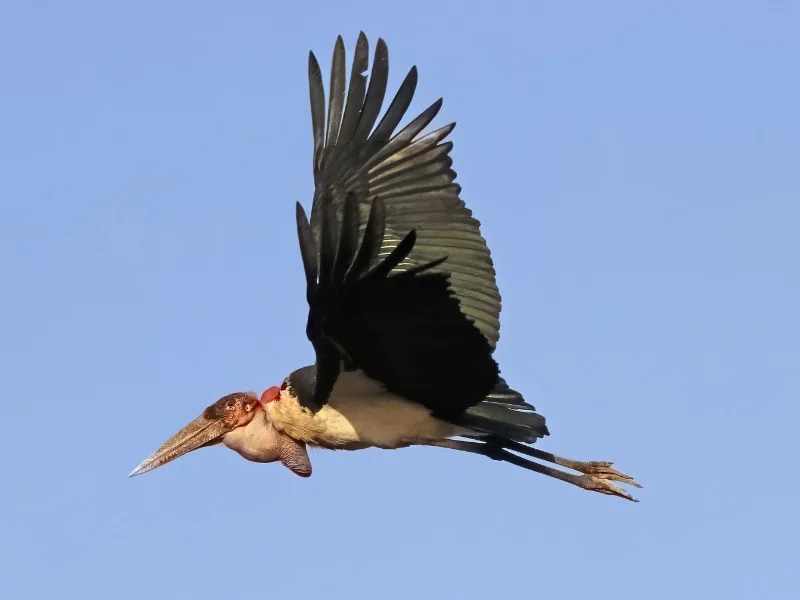
The marabou stork is one of the largest flying birds in Africa, with a wingspan reaching up to 3.2 meters (10.5 feet). Its massive size, combined with its bald head, wrinkled skin, and long, drooping throat pouch, has earned it a reputation as one of the strangest-looking birds in the world. Despite this, it is a highly efficient flyer, taking advantage of thermals to glide with minimal effort. An opportunistic feeder, the marabou stork often scavenges alongside vultures but also hunts fish, small mammals, and even other birds.
Unlike many large wading birds, it has adapted well to human-altered landscapes, frequently gathering near landfills, fishing villages, and urban areas. While its population remains stable and is classified as Least Concern, threats such as habitat degradation and pollution could impact its future numbers. Despite its awkward stance on land, the marabou stork is an impressive glider, effortlessly soaring high above the African plains.
Cinereous vulture (Aegypius monachus)
- Wingspan: Up to 3.1 m (10.2 ft).
- Weight: Up to 14 kg (31 lbs).
- Where found: Europe, Central Asia, and parts of the Middle East.
- Conservation status: Near Threatened.

The cinereous vulture, also known as the Eurasian black vulture, is one of the largest birds of prey, with a wingspan reaching up to 3.1 meters (10.2 feet). This massive scavenger dominates the skies over the mountainous and forested regions of Europe and Central Asia, using its broad wings to soar effortlessly on thermal currents. Unlike some vultures, it is primarily a solitary hunter, feeding on carrion but also known to drive other scavengers away from carcasses.
Despite its impressive size and adaptability, the cinereous vulture faces threats from habitat loss, poisoning, and illegal hunting. Conservation efforts, including protected nesting sites and reintroduction programs, have helped stabilize some populations, but it remains classified as Near Threatened by the IUCN. As one of the heaviest raptors in the world, this vulture plays a crucial role in maintaining healthy ecosystems by cleaning up carcasses and preventing the spread of disease.
Lappet-faced vulture (Torgos tracheliotos)
- Wingspan: Up to 2.9 m (9.5 ft).
- Weight: Up to 9.4 kg (21 lbs).
- Where found: Arid and semi-arid regions of Africa and the Middle East.
- Conservation status: Endangered.
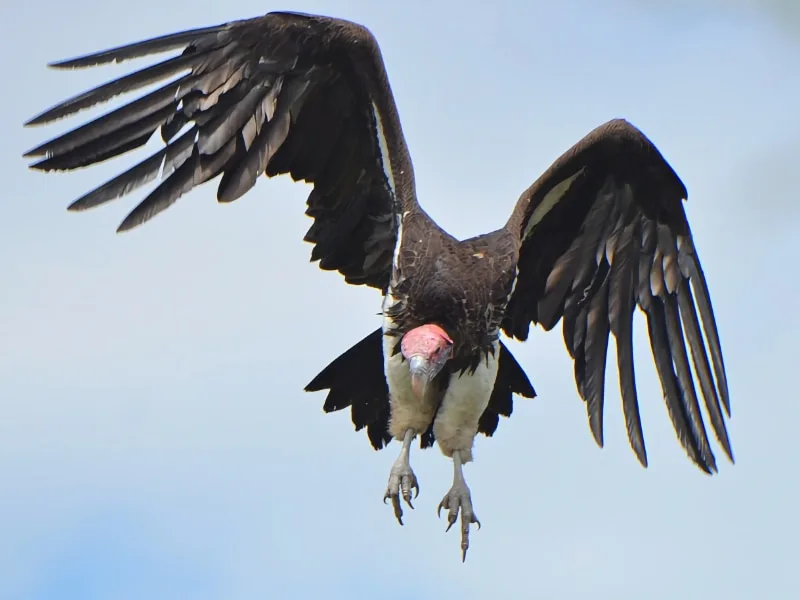
The lappet-faced vulture is one of Africa’s largest and most powerful birds of prey, with a wingspan reaching up to 2.9 meters (9.5 feet). This imposing scavenger is easily recognized by its bare, wrinkled head, deep-set eyes, and strong hooked beak, which allows it to tear through tough hides that other vultures struggle to open. While it primarily feeds on carrion, it is also capable of hunting live prey, including small mammals and birds.
Once widespread, the species has suffered from habitat loss, poisoning, and persecution, leading to its classification as Endangered. Populations continue to decline due to poison-laced carcasses, set by farmers targeting predators but inadvertently killing scavengers. Conservation efforts focused on protecting nesting sites and reducing poisoning incidents are essential for ensuring the survival of this dominant scavenger in Africa’s skies.
Eurasian griffon vulture (Gyps fulvus)
- Wingspan: Up to 2.8 m (9.2 ft).
- Weight: Up to 15 kg (33 lbs).
- Where found: Mountains and open landscapes of Europe, North Africa, and Central Asia.
- Conservation status: Least Concern.

The Eurasian griffon vulture is a powerful soaring bird, with a wingspan reaching up to 2.8 meters (9.2 feet) and an impressive build suited for long-distance gliding. Found across southern Europe, North Africa, and Central Asia, it thrives in mountainous regions and open landscapes, where it uses thermals to cover vast distances in search of carrion. Its pale brown plumage, dark flight feathers, and distinctive bald head make it easy to identify.
Although not currently at risk, local populations have faced declines due to poisoning, habitat loss, and food scarcity. Conservation efforts, including reintroduction programs and feeding stations, have helped stabilize numbers in parts of Europe. As a key scavenger, the Eurasian griffon vulture plays an essential role in the ecosystem, preventing the spread of disease by efficiently disposing of carcasses.
Bearded vulture (Gypaetus barbatus)
- Wingspan: Up to 2.9 m (9.5 ft).
- Weight: Up to 7.8 kg (17 lbs).
- Where found: Mountainous regions of Europe, Africa, and Asia.
- Conservation status: Near Threatened.
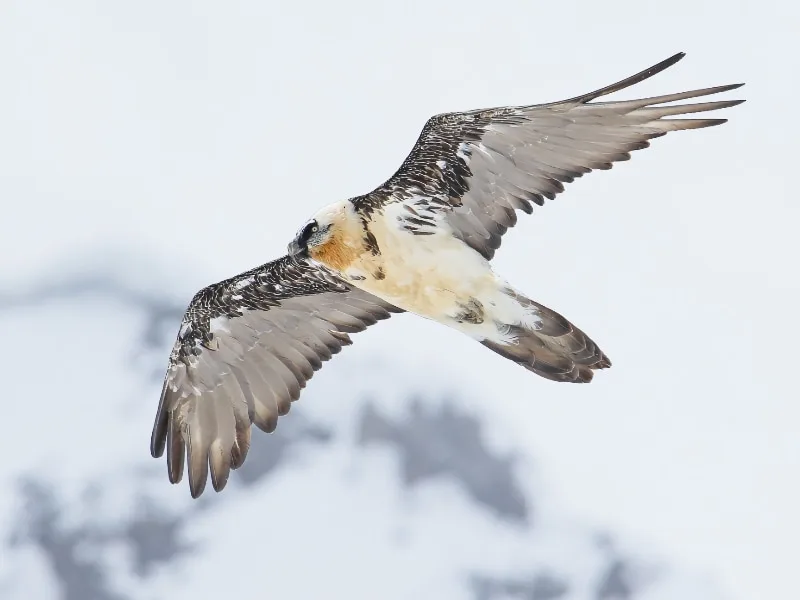
The bearded vulture, also known as the lammergeier, is one of the most distinctive birds of prey, instantly recognizable by its broad wings, wedge-shaped tail, and striking facial markings. With a wingspan reaching up to 2.9 meters (9.5 feet), it is perfectly adapted for soaring over the high-altitude landscapes of the Alps, Himalayas, and African mountains. Unlike other vultures, it feeds primarily on bones, dropping them from great heights to shatter them into smaller, digestible pieces, a behavior that has earned it the nickname “bone-breaker.”
Despite its adaptability, the bearded vulture faces threats from poisoning, habitat loss, and human disturbance. Though classified as Near Threatened, populations in certain regions have declined, leading to reintroduction efforts in parts of Europe. As one of the few birds capable of digesting bones, it plays a unique ecological role in mountainous environments, ensuring that no part of a carcass goes to waste.
American white pelican (Pelecanus erythrorhynchos)
- Wingspan: Up to 3.0 m (9.8 ft).
- Weight: Up to 13.6 kg (30 lbs).
- Where found: Lakes, rivers, and coastal waters of North America.
- Conservation status: Least Concern.

The American white pelican is among the largest waterbirds in North America, with an impressive wingspan of up to 3.0 meters (9.8 feet). Unlike its more coastal relative, the brown pelican, this species prefers inland freshwater habitats, nesting on remote islands in lakes and rivers. It is a graceful flier, often seen soaring in formation with slow, deliberate wingbeats.
Unlike many pelican species, it does not plunge-dive for fish. Instead, it employs cooperative feeding, where groups of pelicans work together to herd fish into shallow waters before scooping them up with their massive bills. Although classified as Least Concern, the species faces localized threats from habitat destruction and human disturbance at breeding sites. Conservation efforts focus on protecting nesting colonies and maintaining healthy wetland ecosystems.
Mute swan (Cygnus olor)
- Wingspan: Up to 2.4 m (7.9 ft).
- Weight: Up to 15 kg (33 lbs).
- Where found: Lakes, rivers, and coastal wetlands of Europe, Asia, and North America.
- Conservation status: Least Concern.

The mute swan is a heavy bird, with some males weighing up to 15 kilograms (33 pounds). Its pure white plumage, gracefully curved neck, and bright orange bill with a black knob make it an unmistakable presence on lakes and rivers. Despite its name, the mute swan is not truly silent – it hisses, grunts, and whistles loudly, especially during territorial disputes, when it becomes one of the most aggressive waterbirds.
These swans are strong, powerful fliers, often taking off with a dramatic display of rapid wingbeats and splashing water as they gain momentum. Though classified as Least Concern, local populations can be affected by habitat degradation, pollution, and lead poisoning from fishing tackle. In some areas, introduced populations have become highly territorial and invasive, competing with native waterfowl for resources.
Trumpeter swan (Cygnus buccinator)
- Wingspan: Up to 3.1 m (10.2 ft).
- Weight: Up to 17.2 kg (37.9 lbs).
- Where found: Lakes, rivers, and wetlands of North America.
- Conservation status: Least Concern.
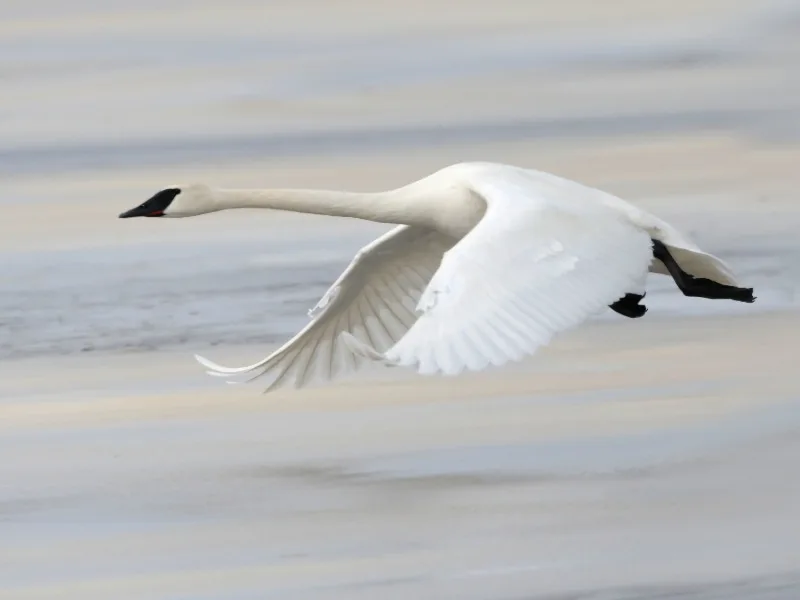
The trumpeter swan is the tallest and heaviest waterfowl in North America, with a wingspan of up to 3.1 meters (10.2 feet) and a long, elegant neck. Unlike the mute swan, which has an orange bill, the trumpeter swan is easily recognized by its entirely black bill and deep, resonant call, which resembles a trumpet – giving the species its name.
Once driven to near extinction by hunting and habitat loss, the species has made a remarkable recovery thanks to conservation programs and reintroduction efforts. While now classified as Least Concern, habitat degradation and human disturbance still pose risks. These powerful fliers migrate seasonally, covering vast distances between breeding and wintering grounds, often flying in graceful V-formations.
Sarus crane (Antigone antigone)
- Wingspan: Up to 2.8 m (7.2-9.2 ft).
- Weight: Up to 12 kg (26 lbs).
- Where found: Wetlands, grasslands, and agricultural fields of South Asia, Southeast Asia, and Australia.
- Conservation status: Vulnerable.
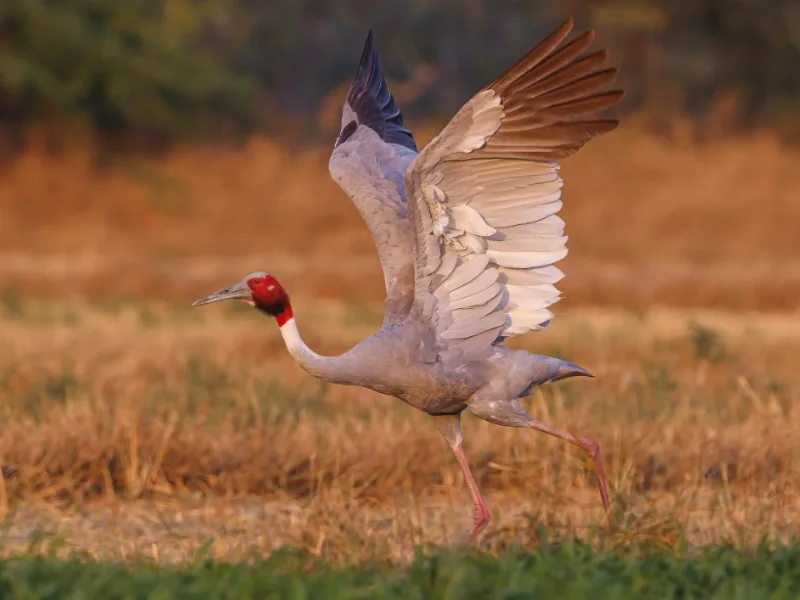
The sarus crane is the tallest flying bird in the world, standing up to 1.8 meters (5.9 feet) tall. Recognized by its striking crimson head and long, slender legs, this elegant crane is a symbol of fidelity in many cultures, as pairs often remain together for life. Unlike many cranes that are highly migratory, the sarus crane is mostly non-migratory, favoring wetlands, shallow lakes, and flooded fields.
Despite its adaptability, populations have been declining due to habitat destruction, wetland drainage, and human disturbances. Now classified as Vulnerable by IUCN, conservation efforts focus on protecting wetland ecosystems and reducing agricultural conflicts. With its slow, graceful wingbeats and loud trumpeting calls, the sarus crane remains an icon of Asia’s wetland landscapes.
Shoebill (Balaeniceps rex)
- Wingspan: Up to 2.6 m (8.5 ft).
- Weight: Up to 7 kg (15 lbs).
- Where found: Swamps and wetlands of Central and East Africa.
- Conservation status: Vulnerable.
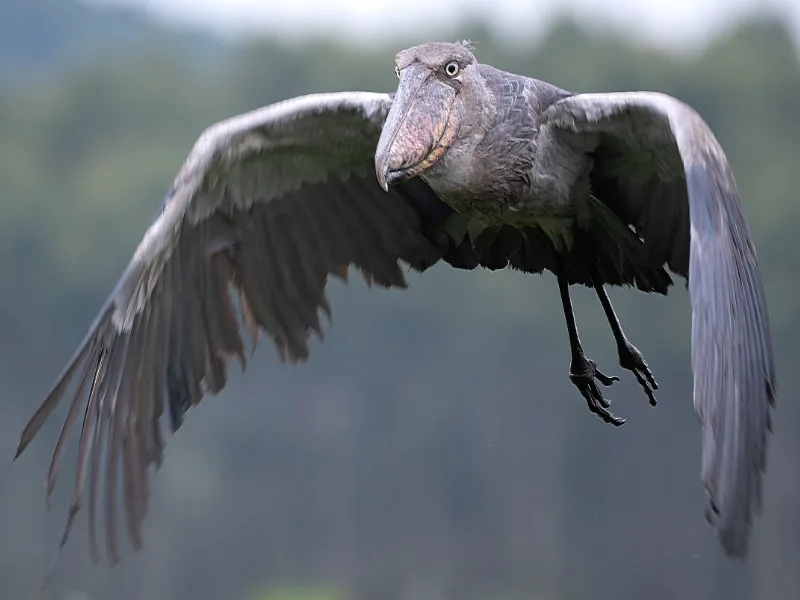
The shoebill is an imposing wetland bird, known for its massive, shoe-shaped bill and prehistoric, almost dinosaur-like appearance, often earning it a spot among the world’s creepiest-looking birds. Despite its large size and wingspan of up to 2.6 meters (8.5 feet), it is a surprisingly stealthy hunter, standing motionless for long periods before striking with lightning speed to catch fish, amphibians, and even baby crocodiles.
Shoebills are solitary and territorial, often found in remote, undisturbed swamps and wetlands in countries like South Sudan, Uganda, and Zambia. Due to habitat destruction, hunting, and disturbances from human activity, the species is classified as Vulnerable, with an estimated global population of only a few thousand individuals. Conservation efforts focus on wetland protection and sustainable ecotourism, as this iconic and enigmatic bird continues to face growing threats in its shrinking habitat.
Magnificent frigatebird (Fregata magnificens)
- Wingspan: Up to 2.44 m (8 ft).
- Weight: Up to 1.6 kg (3.5 lbs).
- Where found: Coastal regions of the Americas, including the Pacific and Atlantic coasts.
- Conservation status: Least Concern.

The magnificent frigatebird is an aerial master, boasting an extraordinarily large wingspan for its lightweight frame. With a wingspan reaching 2.44 meters (8 feet) yet weighing only 1.6 kilograms (3.5 pounds), it is perfectly adapted for effortless soaring, sometimes staying aloft for weeks at a time. These seabirds rarely land on water, as their feathers lack waterproofing, relying instead on piracy (kleptoparasitism), harassing other seabirds into dropping their catch.
Males are unmistakable during the breeding season, inflating their huge, red throat pouch to attract females. Despite their dominance in the skies, frigatebirds are vulnerable to habitat loss and human disturbances at nesting colonies. Protected breeding sites, such as those in the Galápagos and Caribbean, play a key role in ensuring their continued survival.
Greater adjutant (Leptoptilos dubius)
- Wingspan: Up to 2.5 m (8.2 ft).
- Weight: Up to 9 kg (20 lbs).
- Where found: Wetlands and urban areas of India and Southeast Asia.
- Conservation status: Near Threatened.

The greater adjutant is a towering, heavy-billed stork, often regarded as one of the strangest-looking birds in the world due to its bald head, wrinkled throat pouch, and hunched posture. With one of the largest wingspans of any stork, reaching up to 2.5 meters (8.2 feet), it cuts an imposing figure in the wetlands and urban landscapes of India and Southeast Asia.
Once widespread across the region, the greater adjutant has suffered severe population declines due to habitat destruction, hunting, and persecution. Now Near Threatened, its last strongholds are in Assam (India) and Cambodia, where conservation efforts focus on protecting nesting sites and reducing human-wildlife conflict. Despite its reputation as a scavenger, this stork plays a crucial role in the ecosystem, helping to clean up waste and carrion.
Steller’s sea eagle (Haliaeetus pelagicus)
- Wingspan: Up to 2.7 m (8.9 ft)
- Weight: Up to 9.5 kg (20.9 lbs)
- Where found: Coastal regions of Russia, Japan, and the Korean Peninsula.
- Conservation status: Vulnerable.

The Steller’s sea eagle is a true giant among raptors, ranking as one of the heaviest eagles in the world, with females weighing up to 9.5 kilograms (20.9 pounds). Its broad wings, spanning up to 2.7 meters (8.9 feet), make it one of the largest birds of prey, rivaling even the biggest vultures in wingspan. Recognizable by its dark plumage, bright yellow beak, and massive talons, it is a powerful fish hunter, primarily preying on salmon and other large fish along the remote coastal rivers and frozen seas of Northeast Asia.
Despite its dominance, the species is among the most endangered eagles, with populations declining due to habitat loss, overfishing, and climate change. Conservation efforts focus on protecting breeding habitats and maintaining sustainable fish stocks, as this majestic apex predator faces mounting environmental pressures.
Himalayan vulture (Gyps himalayensis)
- Wingspan: Up to 3.1 m (10.2 ft).
- Weight: Up to 12.5 kg (28 lbs).
- Where found: Himalayas, Tibetan Plateau, Central Asia.
- Conservation status: Near Threatened.
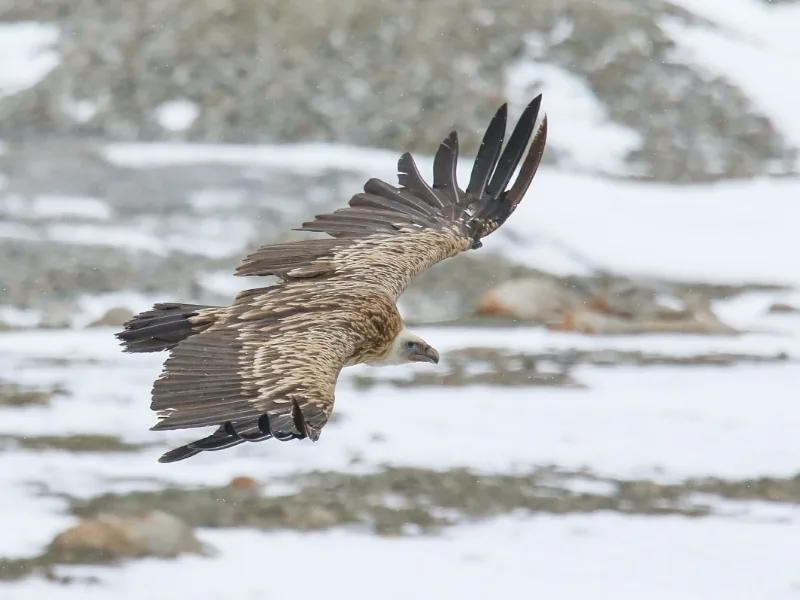
The Himalayan vulture is one of the largest and heaviest flying birds, thriving in the extreme conditions of the high-altitude mountains of Central Asia and the Himalayas. With a wingspan reaching 3.1 meters (10.2 feet), it soars effortlessly on thermal currents, scavenging for carrion in some of the world’s harshest environments. Unlike many vultures, it rarely ventures into lowland areas, preferring the rugged landscapes of Tibet, Nepal, and northern India.
Despite its formidable size and dominance in the skies, the Himalayan vulture faces threats from habitat disturbance, poisoning, and food scarcity due to changes in livestock practices. It is currently listed as Near Threatened, though its populations remain more stable than those of other large vultures. Conservation efforts focus on reducing poisoning incidents and protecting its mountainous habitat, ensuring that this giant of the Himalayas continues to rule the skies.
Rüppell’s vulture (Gyps rueppelli)
- Wingspan: Up to 2.6 m (8.5 ft).
- Weight: Up to 9 kg (20 lbs).
- Where found: Sahel and East Africa, particularly in savannas and mountainous regions.
- Conservation status: Critically Endangered.

Rüppell’s vulture holds a remarkable aviation record, being the highest-flying bird ever recorded, reaching 11,300 meters (37,000 feet) – an altitude where even commercial jets cruise. This large African vulture has broad wings adapted for soaring, allowing it to scan vast landscapes for carrion, a crucial role in maintaining ecosystem health.
Despite its mastery of the skies, this species is Critically Endangered, facing severe population declines due to poisoning, habitat loss, and collisions with power lines. Conservation efforts focus on reducing human-wildlife conflict, particularly in areas where vultures are targeted due to misconceptions or accidental poisoning from livestock carcasses. Without urgent intervention, one of world’s most impressive aerial specialists may vanish from the wild.
What makes these birds so extraordinary
The world’s largest flying birds represent the pinnacle of avian evolution, each adapted to thrive in its own ecological niche. From albatrosses that glide across entire oceans to condors and vultures that ride thermals over mountain ranges, these species showcase the diverse strategies birds have developed to sustain flight despite their massive size. Some, like cranes and bustards, rely on sheer strength to take off, while others maximize wingspan for effortless soaring.
Many of these giants face significant conservation challenges, and protecting them requires international efforts to preserve habitats, reduce human impact, and mitigate threats like habitat loss and bycatch. Whether measured by wingspan, weight, or height, these birds remind us of the remarkable capabilities of nature’s largest fliers.
Further reading

I”m SURPRISED there is no BALD or GOLDEN EAGLE here. They are too small for this list, I’d guess.
Thank you for your comment! In this article, we focused on birds that are the absolute largest in the world based on key size records, whether in terms of weight, wingspan, or height, and we also aimed to represent different bird groups. That’s why only one eagle made this particular list – the Steller’s sea eagle, which consistently ranks among the heaviest and largest of all eagles.
However, both the bald eagle and golden eagle are featured in our article specifically dedicated to the world’s largest eagles! You can check it out here.